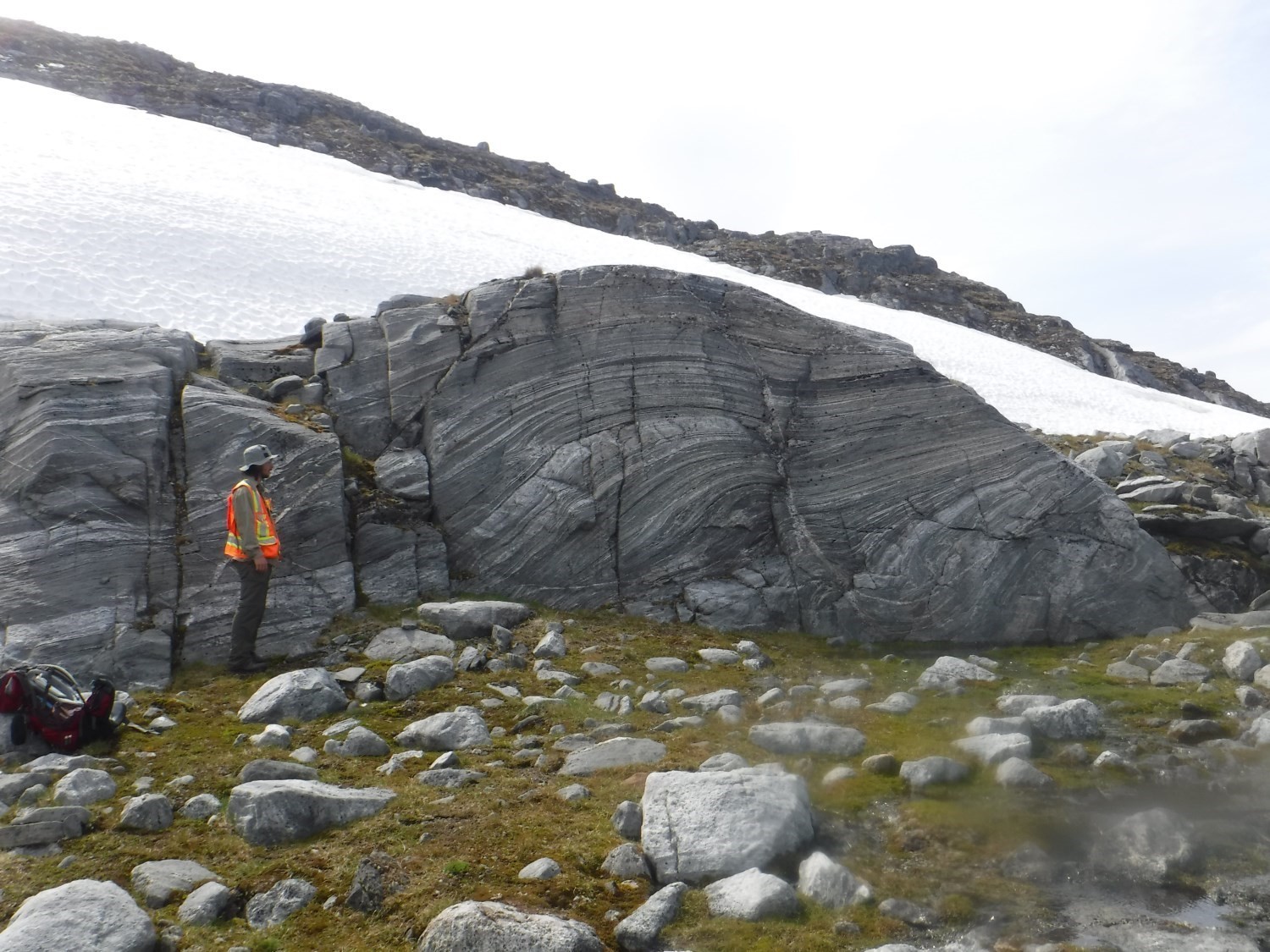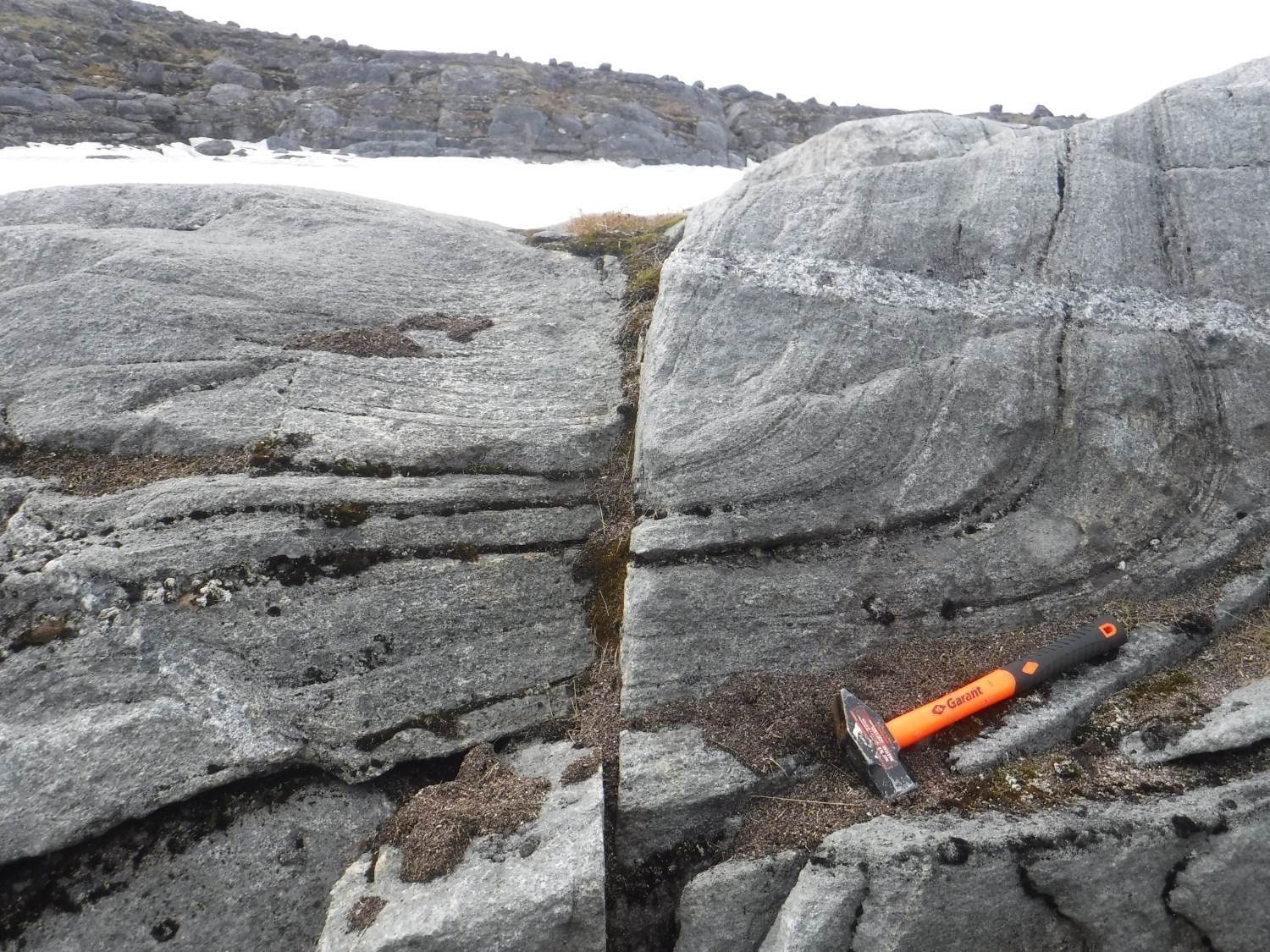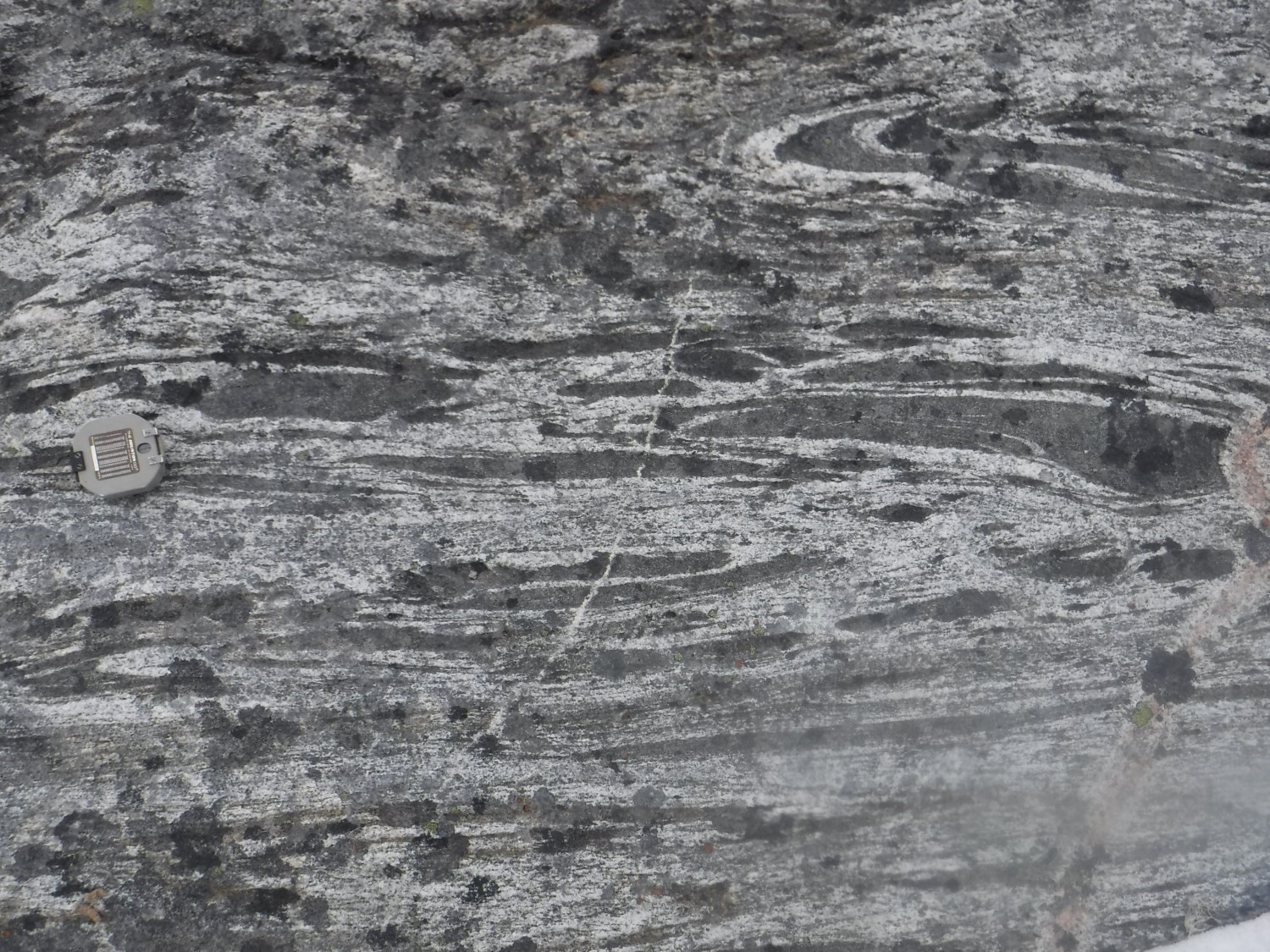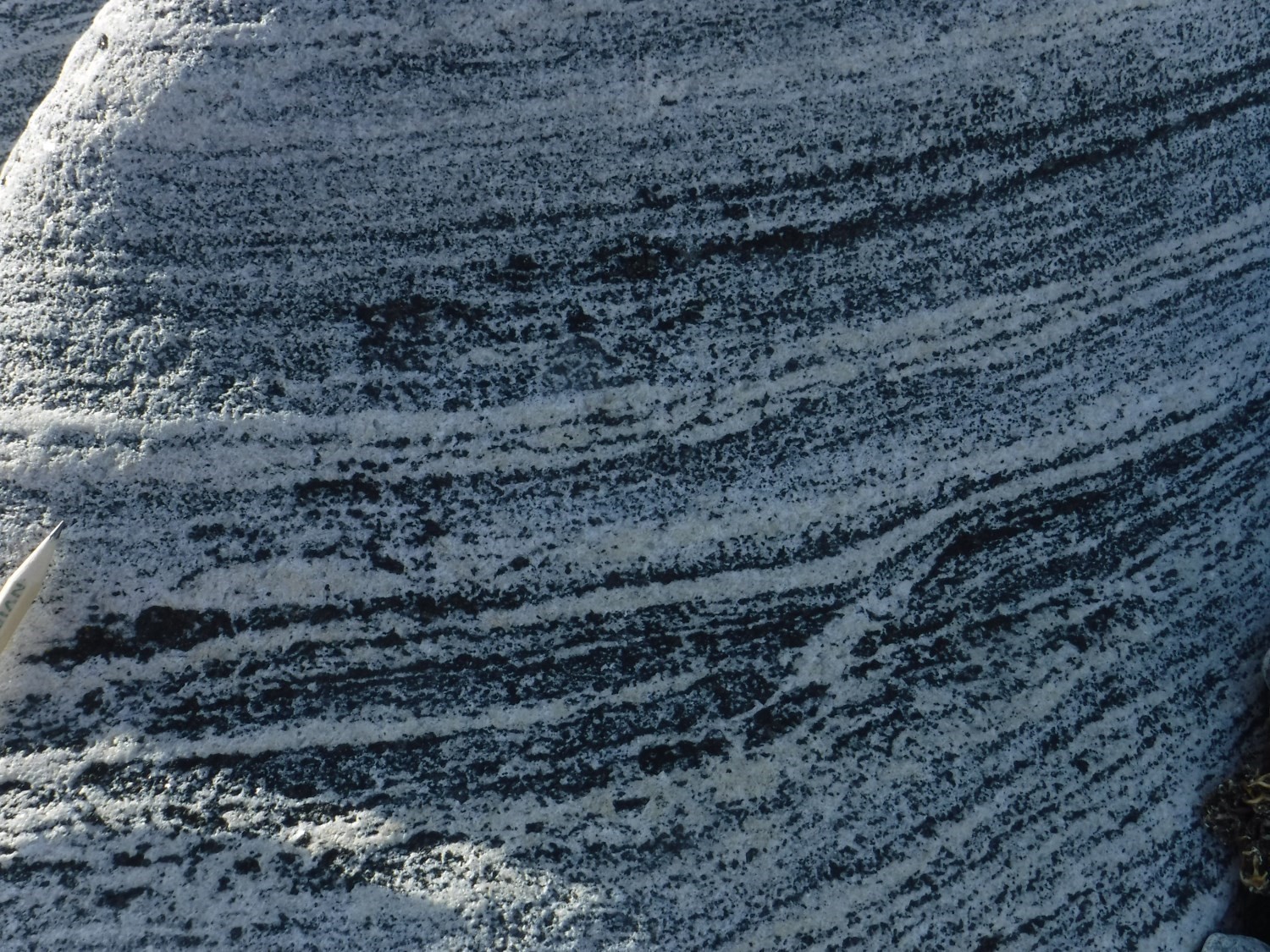
| Author(s) | Vanier and Lafrance, 2020 |
| Methodology | Defined from geological survey and geophysical data |
| Geological(s) subdivision(s) | Churchill Province / Ungava Orogen / Narsajuaq Lithotectonic Domain |
| Main movement | Does not apply. |
| Deformation style | Undetermined |
| Metamorphic facies (mean facies related to main deformation) | Upper amphibolites |
Background and Methodology
This record is based on aeromagnetic maps’ interpretation (Intissar et al., 2014) and information collected from geological survey carried out in the summer of 2019 in the Sirmiq Lake area (Vanier and Lafrance, 2020).
Boundaries and Morphology
| Width | 9 km |
| Length | 19 km |
The Siukkaq Structural Domain (DSsiu) has a lobed morphology. It is bordered to the east by a sinistral shear zone that marks the transition to the Estre Structural Domain (DSest). To the south, it shares a diffuse boundary with the Kuuruq Structural Domain (DSkuu) and to the east, the border with the Routhier Structural Domain (DSrou) is defined by the pattern of foliation traces that form ellipses within the latter.
Stratigraphic Units Concerned
The DSsiu is composed of rocks of the Sainte-Hélène Complex and some klippes of mafic and ultramafic rocks of the Pingasualuit Complex.
Structural Characteristics
❯ Main Fabrics


 Planar fabrics of the DSsiu have variable orientations and dips. Orientations generally follow the domain’s lobed edges. Locally, foliation curves abruptly, changing from subhorizontal to subvertical. There are not enough measurements of linear structures to identify a trend.
Planar fabrics of the DSsiu have variable orientations and dips. Orientations generally follow the domain’s lobed edges. Locally, foliation curves abruptly, changing from subhorizontal to subvertical. There are not enough measurements of linear structures to identify a trend.
Foliation and gneissosity are regular and continuous in the DSsiu. Foliation is emphasized by the planar positioning of biotite and hornblende grains, while gneissosity is marked by the segregation of quartz, feldspar and ferromagnesium minerals at the millimetre scale. Migmatized rocks are present in the DSsiu. These may show stromatic banding parallel to foliation and gneissosity. In places, more irregular migmatitic banding becomes predominant. Amongst others, elongated melanocratic bodies 5 cm to a few decimetres long are arranged subparallel to foliation. In areas where proportions of leucosomes and melanosomes are high, the planar fabric is more irregular and a creep appearance is observed.
| Main Fabric | Type of Fabric | Direction (°) | Dip / Plunge (°) | Number of Measurements | Comments |
| Foliation Sn | Tectonometamorphic foliation and gneissosity | Variable | Variable | 26 | |
| Lineation Ln | Stretch or mineral lineations | Variable | Variable | 4 |
|
❯ Other Fabrics
Not observed.
❯ Folds
Not observed.
❯ Crosscutting Relationships
None.
❯ Kinematics
Does not apply.
Deformation Style
The intensity of deformation in the DSsiu varies from low in diatexite unit of the Sainte-Hélène Complex (pPshn3) to moderate in gneissic and migmatized units of the same complex (pPshn1 and pPshn2). Diatexites are dominant in the centre of the domain, while gneissic rocks are concentrated at the periphery. Within diatexites, there is little structural coherence between outcrops, which are almost one kilometre apart. Several features of the DSsiu are common to the DSrou, including stratigraphic units affected, the type of fabric, the intensity of deformation and metamorphic conditions. In the case of the DSrou, the geometry suggests a style of deformation corresponding to a dome. On the other hand, the geometry of the DSsiu is complex and part of it is unknown since it continues under the Hudson Strait. The deformation style of the DSsiu therefore remains undetermined. However, it is known to be a high-temperature deformed domain, as is the rest of the Narsajuaq Lithotectonic Domain. The complex lobed shapes that compose it could be the result of instabilities due to density contrasts in a crust devoid of rigidity, as proposed for the Sirmiq Lake area (Vanier and Lafrance, 2020). Another hypothesis implies that it would be a sequence of polyphase folds.
Metamorphic Characteristics
The presence of stromatic banding within migmatites of the Sainte-Hélène Complex indicates that upper amphibolite facies metamorphic conditions were reached synchronously with the main deformation (Sawyer, 2008). In general, metamorphic characteristics of the DSsiu are the same as in the adjacent Routhier Structural Domain (DSrou).
Alterations
Not observed.
Geophysical Characteristics
The geophysical pattern of the DSsiu consists of four aeromagnetic ridges of moderate intensity that follow the lobed shape of the domain. The NE part is characterized by an aeromagnetic field of lower intensity.
Chronological Markers
A sample of migmatized tonalitic gneiss from the Sainte-Hélène Complex (pPshn2a) was collected for geochronological analysis. Although analytical results are not available, it is expected that these will constrain the age of the partial melting event and thus provide an estimate of a synkinematic or minimum age. This age will also be valid for the DSrou which includes a large volume of migmatized gneiss of the Sainte-Hélène Complex.
References
Publications Available Through Sigéom Examine
INTISSAR, R., BENAHMED, S., D’AMOURS, I., 2014. Levé magnétique et spectrométrique aéroporté de la partie nord de l’Orogène de l’Ungava, Province de Churchill. MRN. DP 2014-03, 10 pages and 410 plans.
VANIER, M.-A., LAFRANCE, I., 2019. Géologie de la région du lac Sirmiq, Orogène de l’Ungava, Nunavik, Québec, Canada. MERN. BG 2020-02, 1 plan.
Other Publications
SAWYER, E.W., 2008. Atlas of migmatites. NRC Research press, 2008. 371 pages.
Suggested Citation
Ministère de l’Énergie et des Ressources naturelles (MERN). Siukkaq Structural Domain. Quebec Structural Lexicon. https://gq.mines.gouv.qc.ca/lexique-structural/domaine-structural-des-siukkaq_en/ [accessed on Day Month Year].
Contributors
|
First publication |
Marc-Antoine Vanier, Jr. Eng., M.Sc. marc-antoine.vanier@mern.gouv.qc.ca; Isabelle Lafrance, P. Geo., M.Sc. isabelle.lafrance@mern.gouv.qc.ca (redaction); Ghyslain Roy, P. Geo. (coordination); James Moorhead, P. Geo., M.Sc. (critical review); Simon Auclair, P. Geo., M.Sc. (editing); André Tremblay (HTML editing); Céline Dupuis, P. Geo., Ph.D. (English version) |

